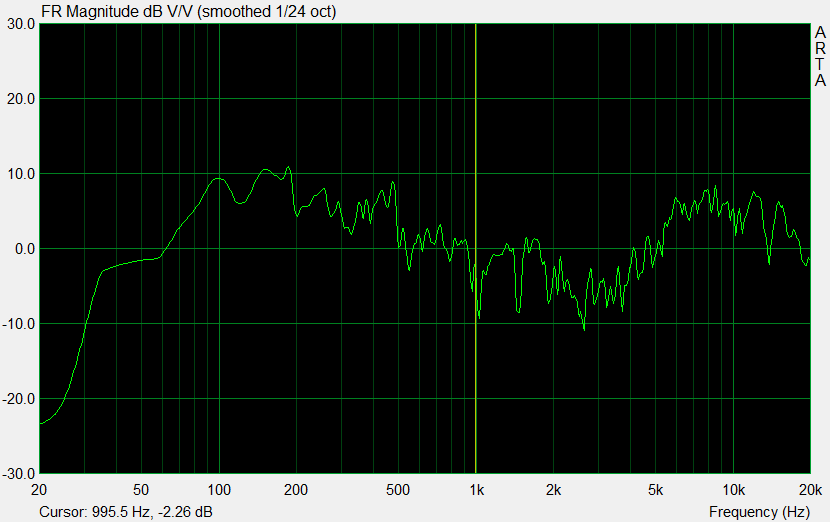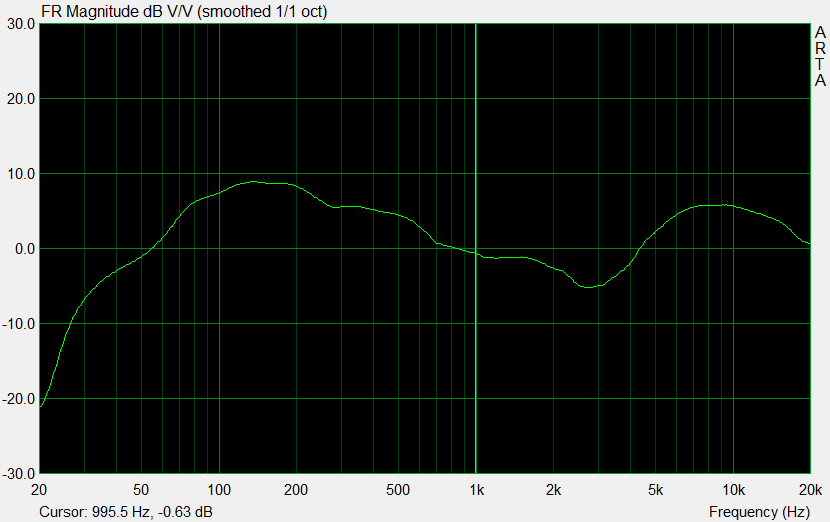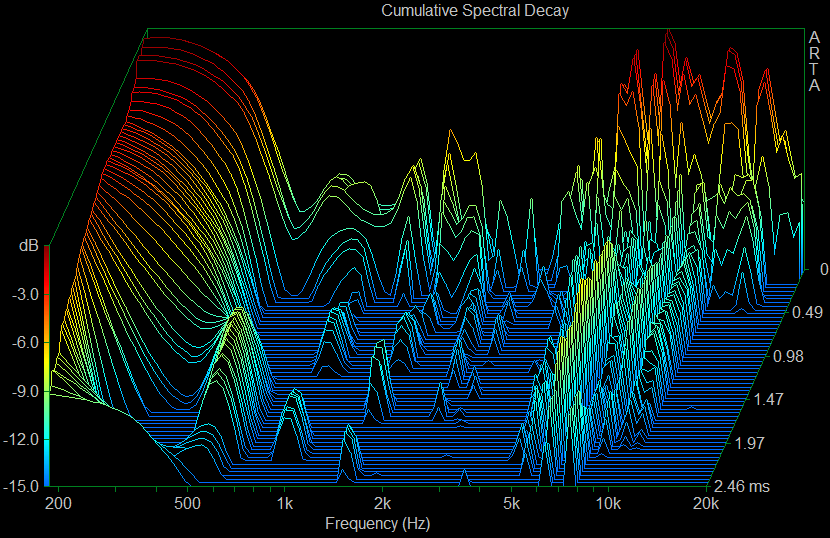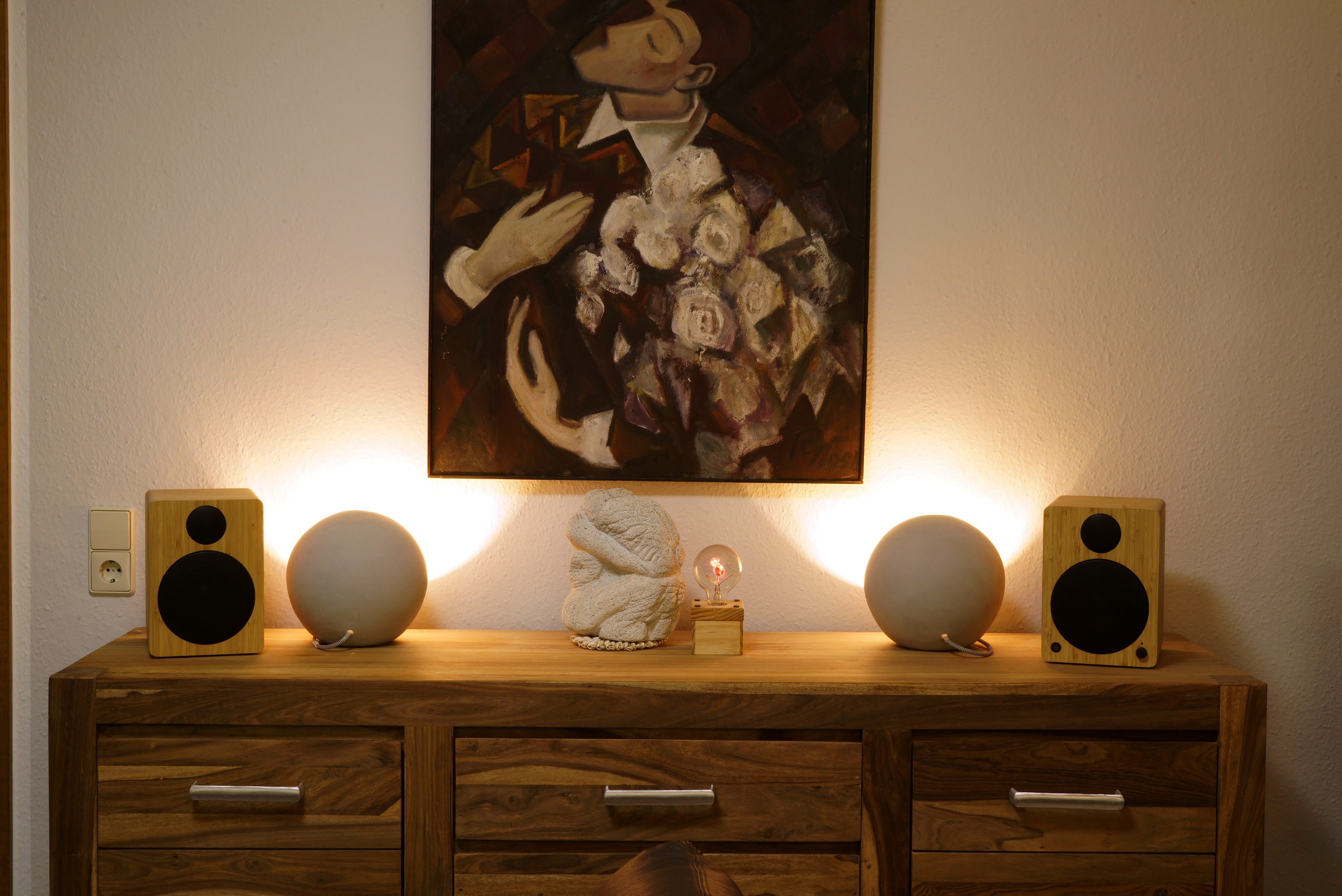Measurement of the frequency curve
I use the pass-through of the DSP with "Defeat" and deactivated Loudness function enabled for measurement. This is the most honest way, because it is a relatively close one to an objective assessment of the frequency progression. The inclined user can still best improve, i.e. salt and over-pepper.
Let's get to the new measurement in the first graphic. Although I have still standardized the frequency curve at 1 KHz to 0 dB, on the one hand it is possible to evaluate the overall course with all encores and frequency waste and on the other hand not quite loses the comparison possibility to previous measurements. But it is still different, because in the first graphic the smoothing is omitted. All of this looks clearly "more hibbeliger", of course, but also fits much better with reality. Because one thing is also clear: it does not exist, the ideal curve.

The second curve represents the same measurement, but smoothes the curve back as usual (as the PR likes to use). You can see the difference and everyone can now orientate themselves on what they prefer. Professional (above) or consumer looking for a rough clue (below)

We can also see a clear V without DSP and with neutral sound adjustment, i.e. the increase in the bass range, as well as the typical peak in the high-frequency range. This is so intentional and will probably appeal to the normal user. If you deactivate Defeat and activate the Loudness function, this curve becomes an alpine extra experience. But the crowd will probably like it that way.
Cumulative Spectral Decay (CSD)
The curves of the spectral decay analysis provide further very useful information about the performance of the installed drivers in combination with the mechanical execution of the box. This analysis is based on the frequency response diagram shown above, but also contains the element Time and now shows as a 3D graphic ("waterfall") very clearly how the frequency response develops over time after the input signal has been stopped. In colloquial terms, such a thing is also called "end" or "swingout".
Normally, the loudspeaker should also stop as quickly as possible after the input signal has been omitted. However, some frequencies (or even entire frequency ranges) will always subside slowly and then continue to appear in this chart as longer-lasting frequencies on the timeline. This is a good way to see where the chassis might be particularly "squeaming" or where resonances (also and especially in the chassis) can occur and disturb the overall picture.

One can see very nicely that especially the tweeter is a bit overpowering, which could also be due to the switch. For my personal taste, all this sounds quite crispy and in the end the overemphasis on heights is certainly also popular with the mainstream and ultimately a question of cost that arises in the chassis selection.
In direct comparison, the old cubes sound much more restrained, albeit almost musty in places. Somehow Wavemaster has fallen from one extreme to the other, but if necessary you can also brake the heights manually via DSP, then it works again with the AOK-compatible tinnitus prevention.
Subjective hearing impression
If we first assume the optimal location, which is definitely worth looking for, then the whole vehicle does not even sound bad for the size and above all surprises full and voluminous, if one does not overdo it at the level. Because you don't have real reserves with this small system. Let's analyze the whole listening experience in a usual breakdown.
Bass
The bass is present (unfortunately somewhat location-dependent) and the contraoctave (32.7 to 65.4 Hz) is still quite present in parts. The subcontraoctave (16.4 Hz to 32.7 Hz) is completely missing, which is due to physics and technical implementation and thus does not represent a shortcoming. The large bass drum, which is usually based on approx. 55 to 60 Hz, on the other hand, already sounds quite crisp, but without really dominating everything else. But the boxes can also be really deep, whoeven even with manageable levels.
The upper bass up to 150 Hz, in which also the Great Octave (65.4 to 130.8 Hz) lies, is almost too dominant. The basic voice frequency of the male voice is in exactly this range; in this way, he decides very strongly on the true-to-life reproduction of mainly male vocals. This still sounds quite convincing with the test device, even if it is almost a little too much of a good thing. Here you should really consider not adding too much bass by controller.
Frequency range
The lower mids (also called the basic tone range) are approx. 150 to 400 Hz. Together with the already mentioned upper bass, this area plays a very important role for the subjectively perceived heat or bass. Fullness of the sound. The basic language frequency of female voices can be found in this area – also well successful and also not as overemphasized as just as with the gentlemen. The upper middles up to about two kilohertz are also reproduced quite cleanly.
High-pitched range
Between two to about 3.5 KHz, human hearing is most sensitive, especially since this range of the lower heights is responsible for the good overtone reproduction of the human voice. This frequency range is crucial for the recognition of a voice or instrument; in this context, one also speaks of the respective timbre.
Here we also find the only hole in the sound carpet, whereby it can probably still be attributed to the switch and in the end represents the characteristic of many such 2-way boxes. But you can live with it, because it's not really serious. It can also be somewhat neutralized by the slight lowering of the heights (and basses).
The middle heights (3.5 to six KHz) decide on the sound or failure of the speech reproduction as a whole, because the S- and hissing (Sibilants) fall into this range. Here the Wavemaster Cube Neo can still convince, but you kind of exaggerate it a little bit. Thus, the Cube Neo sound much sharper than the previous version. You might even like it (but it doesn't have to be).
The upper heights up to approx. Ten KHz are also bathtub-heavy and thus once again served to the mainstream, but what's the point, you can still kill them if necessary. Better to be present first and with the chance to minimize than to have to complain about the total loss already at the factory. Klaus Kevin, on the other hand, will be pleased.
Conclusion and summary
 The bottom line is that all of this fits together quite well, even if they are neither overly loud party nor real hi-fi speakers. But they are good and space-saving all-rounders for people with little space and the basic demand for affordable quality – the usual compromise that is usually hard to find.
The bottom line is that all of this fits together quite well, even if they are neither overly loud party nor real hi-fi speakers. But they are good and space-saving all-rounders for people with little space and the basic demand for affordable quality – the usual compromise that is usually hard to find.
Actually, everything is relatively free of criticism – from the body to the chassis to the amplifier solution. If you tweak a little bit, it is the slight background noise at the analog entrance, the already pre-glued feet and the slightly too pronounced bathtub tuning. The latter can also be slowed down again via the excellent remote control.
If you don't want hall sound and are otherwise a more neighbour-compatible contemporary, you would have a pretty passable offer with the Wavemaster Cube Neo, which does a lot of things right and hardly anything wrong. The road price of well below 200 euros is certainly an additional incentive, especially since the whole thing is likely to become a little cheaper over time.

































Kommentieren